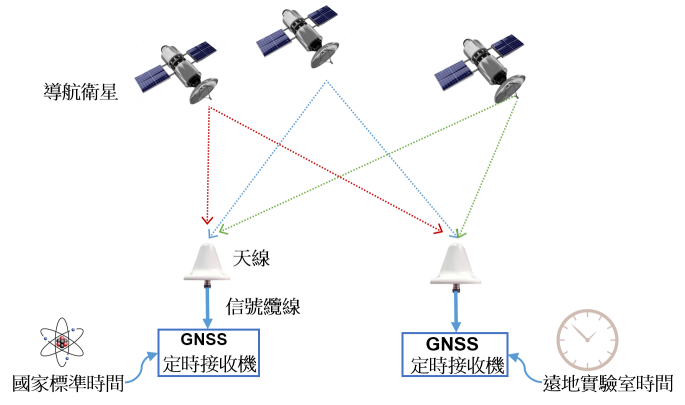GNSS Time Transfer
Our National Laboratory is equipped with an array of navigation satellite receivers, providing the capability to measure various ephemerides and carrier phases of the principal navigation satellite systems. These receivers are employed for several critical functions:
1.International Time Comparison: This involves maintaining the national standard time and ensuring its synchronization with Coordinated Universal Time (UTC).
2.Participation in the International GNSS Service (IGS): Under the station identifier TWTF, the laboratory generates precise positioning data, serving as a crucial satellite control point within the country.
Provision of Remote Time and Frequency Calibration Services to Domestic Manufacturers.
The laboratory is recognized as a Group-1 facility by the International Bureau of Weights and Measures (BIPM) for Global Navigation Satellite System (GNSS) receiver calibration. We actively engage in BIPM's GNSS receiver calibration round-robin activities, also tasked with calibrating GNSS receivers for Group-2 laboratories within the Asia-Pacific region, thereby contributing to the establishment of a global time and frequency standard traceability network. Presently, there are nine Group-1 laboratories globally, including three in the Asia-Pacific region.
Overview of GNSS Precision Time Transfer Techniques
GNSS receivers, capturing one-way satellite signals for time and positioning, are influenced by various factors such as receiver and antenna types, signal cable quality, antenna coordinate errors, ionospheric and tropospheric satellite signal delays, multipath signal interference, and co-frequency electromagnetic interference. The time accuracy output of GNSS receivers varies, ranging from several nanoseconds to microseconds, depending on the receiver type and error correction methods. Factors like proper installation and antenna delay calibration also significantly impact GNSS timing accuracy

Navigation Satellite Time Transfer Techniques Explained
Accurate time comparisons between clocks at different locations can be made by exchanging and analyzing time measurement data from GNSS receivers. Some commonly used GNSS time transfer techniques are:
1.Common-View Method: This is the simplest and earliest technique for comparing clocks in different locations using GNSS, based on ephemerides. It eliminates common variabilities observed by receivers in separate locations, enhancing time transfer accuracy. When receivers are less than 3000 km apart, they can simultaneously observe more satellites on highly similar receiving paths, thereby effectively neutralizing most disturbances. However, the effectiveness diminishes as the distance between receivers increases.
2.All-In-View Method: Also ephemerides-based, this method has been employed by BIPM since 2006 for International Atomic Time (TAI) calculations, becoming a primary method for long-distance comparisons. The all-in-view method is less dependent on the distance between two laboratories. It calculates the time difference between two laboratories by averaging individual lab observations of GNSS satellites, determining the variance from the IGS reference time. This method transcends distance limitations due to the intermediary of a common reference time.。
3.Precise Point Positioning (PPP) Technology: PPP utilizes the carrier phase of GNSS signals, refined with models for precise satellite orbits, satellite clocks, and geoscience factors, to derive time and frequency comparison data. The Integer Precise Point Positioning (IPPP), developed by BIPM for precise time and frequency comparison, requires uninterrupted phase measurement data. A laboratory using IPPP needs multiple receivers to ensure continuous phase data, avoiding uncertainties during data gaps or reboots. IPPP, being more stringent than PPP, necessitates a clear count of weeks for continuous time comparison results.
Moreover, our laboratory is developing an up-sampling technique, which integrates GNSS observation data with predictive augmentation data through algorithms, aiming to enhance the accuracy of long-distance time transfer comparison data. Our up-sampled common-view method, published in international journals, has notably improved the precision of time transfer comparisons between the German PTB and our laboratory using GPS P3 ephemerides.。
